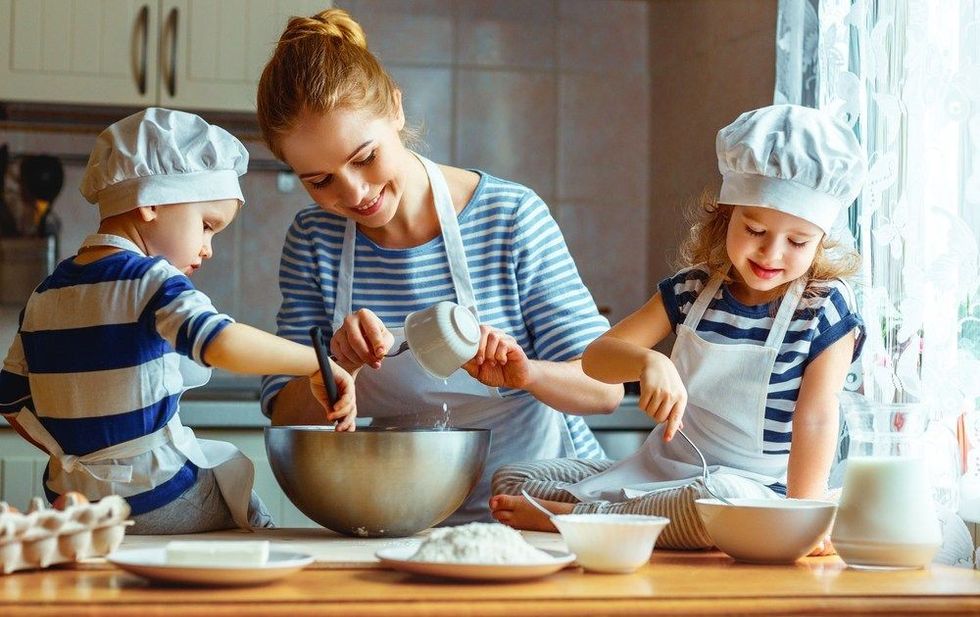Image ©svetlanasokolova, under a Creative Commons license.
If your child is into photography, look no further than this simple camera cake bake which is bound to make their birthday magical!
Although it looks daunting, this cake is actually made of carved out sponge cakes, glued together by frosting. With this handy recipe, you'll have a picture perfect camera birthday cake in no time!
This bake will be a perfect surprise for your child and will look great on all the photos.
If you are looking for more fantastic bake ideas, why not take a look at our tutorials for a book cake or a football cake?
What You Need:
For The Cake: 355g all-purpose flour, 225g unsalted butter (at room temperature), 300g caster sugar, 4 large eggs (at room temperature), 240ml milk, 1 tbsp baking powder, 1 tbsp vanilla extract, a pinch of salt.
For The Frosting: 100g unsalted butter (at room temperature), 180g icing sugar, 340g cream cheese, 1 tsp vanilla extract.
For The Icing And Decoration: Black ready-to-roll fondant icing, a white icing writing pen.
Equipment: A 9"x13" (23cm x 33cm) sheet cake tin, an electric whisk or mixer, a cake board or large flat plate, a circular container like a bowl or a cookie cutter (8cm diameter).
This cake can take up to three hours to prepare, depending on how much decoration you include. Children as young as two can help you mix the dry ingredients together with a manual whisk, but the electric whisk should be saved to be used by older children with adult supervision.
Decorating is a delicate process, but kids from the age of five can help you roll out the icing!
Method:
1) Preheat your oven to 180°C (350°F). Place an oven rack in the centre of the oven. Grease your cake tin with some softened butter or margarine. You could also line it with baking paper for extra safety.
2) Start on your cake batter: in a bowl, mix and whisk your flour, baking powder and salt.
3) In a different bowl, beat the butter, caster sugar and vanilla extract with an electric whisk (on medium-high speed) until it becomes light and fluffy. This should take three to five minutes.
4) Add the eggs to your butter and sugar mixture, one at a time, and keep beating well.
5) Turn the whisk or mixer to low speed and add a third of the dry ingredients, then half of the milk. Keep alternating and mix until you have added all of your ingredients.
6) Pour the batter into the cake tin, smooth the top of the mixture with a spatula or spoon. Bake the cake for about 35 minutes.
To check whether it is ready, insert a knife or a toothpick into the centre: it must come out clean before you can take it out of the oven. Once it is out of the oven, place the cake onto a rack to cool for at least 15 minutes.
7) While you wait for the cake to cool, prepare the frosting: with your electric whisk or mixer, beat the butter until it is light. Add the icing sugar and keep whisking until the mixture becomes fluffy.
8) Add the vanilla extract, then the cream cheese, gradually. Beat until the ingredients are fully incorporated.
9) It's time to assemble your cake! In order to make the shape of a camera, cut out two circles from the edge of your cake; these will form the lens. To do so, use the large cookie cutter or a circular container like a bowl (diameter should be about 8cm).
10) From the rest of the cake, carve out two rectangles, which will be the main part of the camera. Depending on what model of camera you are basing the cake on, you might want to carve out the shape of the flash on the top of your rectangle.
If you are unsure of the design, you can refer to a photo.
11) The frosting is the glue which will make your cake stick together. Layer one tablespoon of frosting onto one of the circles, then sandwich the other one on top. Do the same with your rectangles.
12) Add a layer of frosting onto the top of the circular cakes. Place the rectangular cake on one of its sides on your cake board or serving plate, then place the circular cakes (your 'lens') against it so the frosting is against the rectangular cake.
13) And now, to decorate! Cover your whole camera cake in a layer of frosting. This doesn't have to be neat, because it will be covered by icing.

14) Roll out the black fondant icing into a thin layer, wrap it around your rolling pin and gently place it on top of the camera cake. Smooth out the icing with your hands and cut out any excess. On the end of your cake lens, you can add a 2cm wide ribbon of black icing.
15) You should have a camera-shaped cake, but the details need to be done! That's where your icing pen comes in handy. With the white pen, draw on the little numbers on the camera lens - we would recommend basing this on a photograph or an actual camera!
On the back of the camera, you can draw on any buttons like navigation, ISO, etc. On the front of the camera, you can draw on the camera brand name (Nikon, Canon, etc). There you have it, a camera cake!
Tips And Recommendations
This camera cake should serve about 12 people. Children as young as two can enjoy a slice, but it contains a lot of sugar, so be mindful of portion sizes.
If you have any children with allergies, you can substitute the plain flour for a gluten-free alternative such as spelt.
Although it is best eaten fresh, this cake can be made in advance and kept in a cool place in an airtight container for up to five days.
You can also freeze it by leaving it in the freezer for an hour to set the icing, then wrapping it in clingfilm and putting it in the freezer in an airtight container for up to two months.
You could make a chocolate camera cake by adding cocoa powder to the frosting and using your favourite chocolate cake recipe!
If you want to add details to the decoration, you could make a strap from black fondant icing: simply roll out it out and cut a 3cm wide strip, place it around the front of your camera cake, attaching it to the sides. You could also use a red icing pen and add extra elements to your camera cake!









